Academic Building, 4th Floor
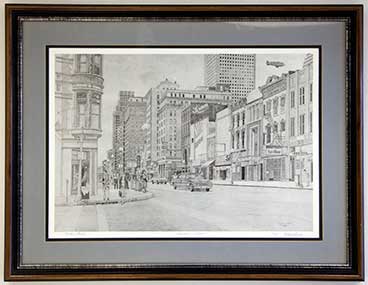
Main Street, Houston Proud! Steven Besselman
Public Art of the University of Houston System
Gift of M.T. Sandoval, Houston
Viewpoint from North East corner of Main & Congress.
On the left is the 1889 Sweeney, Coombs & Fredericks Building at 301 Main Street. Only one of two remaining buildings still standing of architect George E. Dickey, the building is know for its corner turret. Until 1907 it was occupied by Sweeney, Coombs & Fredericks Jewelers. Almost destroyed by the Harris County Commissioners Court they were persuaded to remodel it and today houses the county engineer.
Across the street at 302 Main is the Sterne Building, built in 1914-16 by Finger & Bailey architects. Next door at 306-310 Main is the Stuart Building, built in 1879-1880, architects unknown. At the end of the block at 320 Main Street, is the 1893 Klam Building, H.C. Holland architect. Built in Romanesque Revival style, it has a distinctive arched entry, bull nose corner on the first floor with upper floors leased to professionals. The building had the city's first electric elevators. Sakowitz operated the building from 1918-1929. The building was restored in 1981.
Across the street at 402 Main is the Public National Bank Building built in 1925 by James Ruskin Bailey. In the middle of the block at 412 Main is the 1924 Alfred C. Finn State National Bank Building. In the background is the 1929 Gulf Building (now Chase Bank) also designed by Finn, Kenneth Franzheim and J.E.R. Carpenter at 712 Main Street.
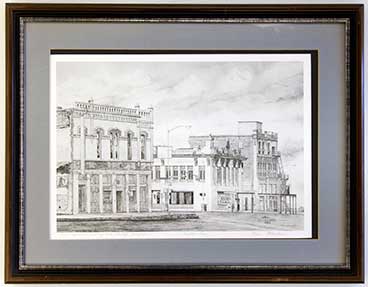
The Magnolia Brewery and Radoff, Steven Besselman
Public Art of the University of Houston System
Gift of M.T. Sandoval, Houston
The Magnolia Brewery Building located at 719-721 Franklin Avenue is the remaining part of what once was an extensive complex of brewery buildings that spanned Buffalo Bayou. Built in 1893 by Cook & Company architects this building was the taproom and executive offices of one of Houston's largest turn-of-the-century industries. The floods of 1929 and 1935 destroyed all but a few of the original buildings. The first refrigerated type air conditioning system was installed in this building. A series of restaurants have occupied this site for the past 20 years.
Across the street from the Magnolia Brewery was the Radoff Building at 202-204 Milam Street. It was build in 1896 by August Baumbach. In 1919 the building was purchased by the Radoff Brothers Notion Company who made some architectural changes and added their name to the structure. For many years LaBastille (night club) was located in the basement. The building was demolished and replaced by a parking lot and drive-in bank in the late 1980's.
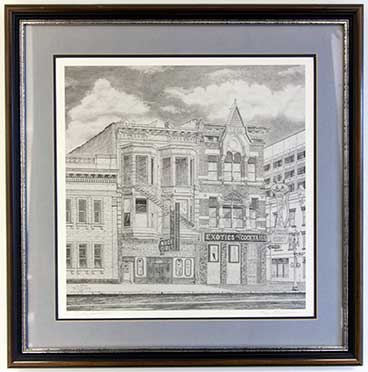
Exotic Architecture, Steven Besselman
Public Art of the University of Houston System
Gift of M.T. Sandoval, Houston
The B.A. Shepherd Building stood at the corner of Main and Congress Streets. Built in 1883 by architect George Dickey (who also designed the Sweeney, Coombs & Fredericks Building across the street) for Shepherd who established a private banking house which later merged with First National Bank. The building is in High Victorian Gothic style. A 2-story iron grillwork canopy went around both side of the building and continued up to the third floor below the entrance pediment. The building remained in family hands until 1966.
Next door at 217 Main Street was the Dumble Building, ca. 1880. George Dumble originally headed a decorative metals firm but in 1893 reorganized into the firm of Dumble, Armistead & Cronan which handled anything connected with tin, sheet iron and cornice work. The building was remodeled sometime between 1894 and 1904.
215 Main Street was the location of the South Texas Commercial National Bank. Designed by C.D. Hill in 1910, wings were added by architect William Ward Watkin in 1922. The building was bought by the United Fund in 1961. This building is listed in the National Register. It was hoped that these buildings would undergo restoration but a few years ago the buildings were demolished and a surface parking lot is now in their place.
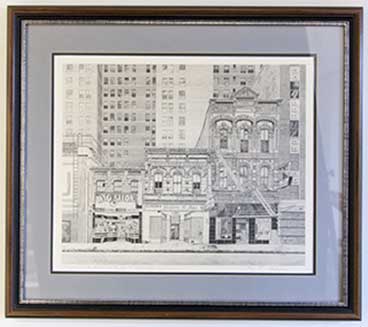
Forgotten in the Shadows of the City-A Golden Era Survives, 1984 Steven Besselman
Public Art of the University of Houston System
Gift of M.T. Sandoval, Houston
Standing at 910 Prairie Avenue, behind the Rice Hotel, (now being renovated) stands the impressive 1882 Henry Brashear Building. It was built by prominent Houston architect Eugene T. Heiner for Brashear for the sum of $8.500. The building is heavily plastered to resemble stone work and has a cast iron cornice and iron front first floor. The building was remodeled several years ago. Today Solero's Restaurant occupies the first floor.
Next door at 912 Prairie the Scholibo Building was built in 1880. The original central pediment which contained this date is now missing. C.F. Scholibo was a baker and grocer, but is known for housing Houston's first steam laundry. The Troy Steam Laundry once employed 41 people and finished 1,000 shirts daily.
The Stegeman Building (wig salon) at 914 Prairie was either built or remodeled by Frederick W. Stegeman in 1879. It has housed numerous enterprises through the years and hopefully will someday undergo restoration now that the Rice Hotel is being remodeled.
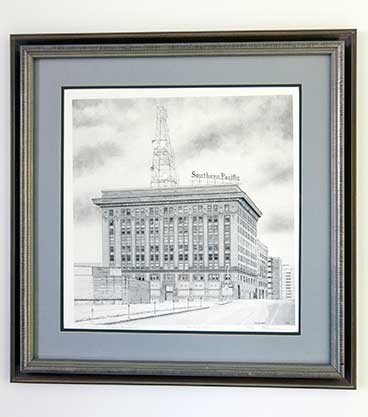
The Southern Pacific Building, Steven Besselman
Public Art of the University of Houston System
Gift of M.T. Sandoval, Houston
The Southern Pacific Building at 913 Franklin Avenue was designed by Chicago architect Jarvis Hunt in 1911 in the Renaissance palazzo style. The 9-story building was the regional headquarters for the Southern Pacific Railway Company. Patterned brick pendants and ornamental panels of brick and tile provide ornamentation detailing around the structure. The building was one of the first Houston buildings to be equipped with refrigerated air ventilation system. There are renovation plans to convert the building to loft apartments in the near future.
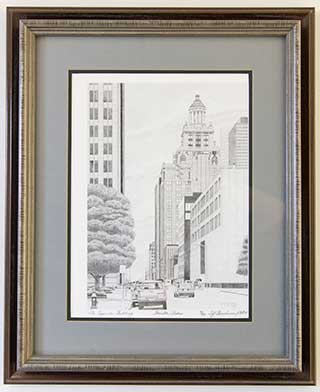
The Esperson Building, Steven Besselman
Public Art of the University of Houston System
Gift of M.T. Sandoval, Houston
The Neils Esperson Building was built in 1927 and was designed by Chicago architect John Eberson. Mellie Kennan Esperson had the building constructed as a memorial to her husband, a Danish-born real estate and minerals speculator. The 32-story building, located at 808 Travis Street, is noted for its Italian Renaissance detailing. The Esperson Building is a favorite downtown landmark.
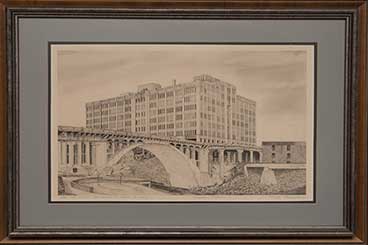
M&M Building-University of Houston-Downtown, Steven Besselman
Public Art of the University of Houston System
Gift of M.T. Sandoval, Houston
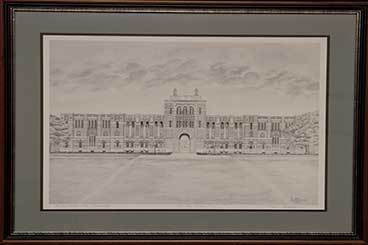
Lovett Hall, Rice University, Steven Besselman
Public Art of the University of Houston System
Gift of M.T. Sandoval, Houston
Lovett Hall was named for Rice University's first president, Edgar Odell Lovett. It was built in 1912 and designed by architect Ralph Adam Cram of the Boston firm of Cram, Goodhue & Ferguson. Cram was commissioned by Lovett in 1909 to design the campus of the newly-organized Rice Institute. For these buildings Cram departed from his usual Gothic Revival designs to create a "southern" style which included cloistered passageways to catch the prevailing breezes. The building originally contained classrooms, administrative and faculty offices, library and faculty chamber.
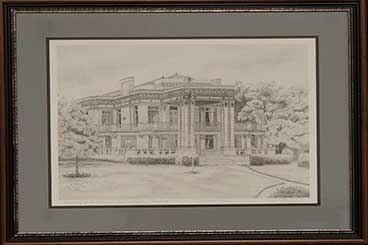
The University of St. Thomas, Administration Building, Steven Besselman
Public Art of the University of Houston System
Gift of M.T. Sandoval, Houston
Located at 3812 Montrose Boulevard, this house was built in 1912 by John Wiley Link who was the developer of Montrose and later became the president of Dr. Pepper. The home sat on a square block in the middle of his subdivision. Link built the house to showcase the types of homes that he hoped would characterize Montrose Boulevard. Originally there was a landscaped esplanade that ran in front of the house.
The facade of the house is enhanced with vitrified buff brick, enameled terra cotta, glazed tile and Missouri limestone. The house contained a full basement and third floor ballroom. Link sold the house to oilman Thomas Peter Lee around 1916. Since 1946 the house has served as the administration building for the University of St. Thomas. The grounds still contain the original garage apartment and pergola; the fence that now surrounds the building is a new addition.
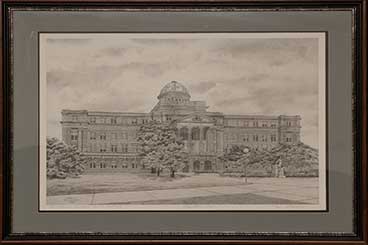
The Academic Building A&M University, College Station, Texas, Steven Besselman
Public Art of the University of Houston System
Gift of M.T. Sandoval, Houston
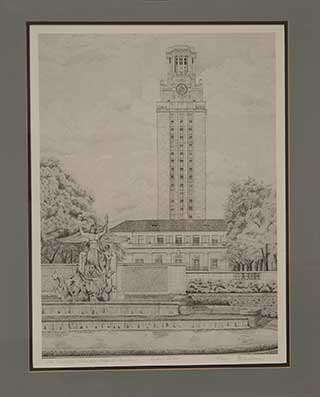
The University Tower and Littlefield Fountain, University of Texas at Austin, Steven Besselmen
Public Art of the University of Houston System
Gift of M.T. Sandoval, Houston
